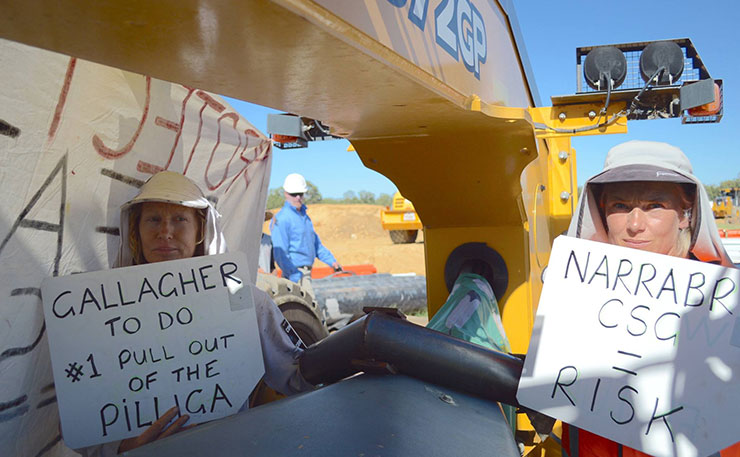In New South Wales, the anti-coal seam gas movement is winning.
There will be no gas fields in the Northern Rivers, or at Gloucester in the Hunter Valley. Late last week the state’s biggest proposal, Santos’ Narrabri Gas Project, came crashing to its knees.
The 850-well gas field has effectively been mothballed, and Santos’ new Chief Executive Officer Kevin Gallagher will be weighing up whether to pit the struggling company against a fierce and building protest movement.
On Friday, Santos posted a $2.7 billion full-year loss for 2015.
At the same time, it wrote-down the value of the Narrabri Gas Project by a further $588 million, after an $808 million impairment in 2014. In total, that’s nearly $1.4 billion over two years, for a project that Santos paid $924 million for in 2011.
In other words, they’ve conceded that the Narrabri Gas Project is virtually worthless. Unfortunately for Santos, though, the hundreds of people who have protested the project are more concerned about the value of the bushland it would snake through.
The Narrabri Gas Project would send tendrils through the largest and most intact eucalypt woodland in eastern Australia. The Pilliga forest would be dissected by access roads, well pads, pipelines, and flares.
The Pilliga is a vital recharge zone for the Great Artesian Basin – one of only a handful in the vast area covered by the underground water store – and protestors are determined not to risk Santos ruining it.
Yesterday, around 80 people occupied a key piece of Santos infrastructure, the Leewood waste water plant which has been under construction for the last few months. It wasn’t the first time.

For the last two months, Santos has faced almost daily protest, and 29 people have been charged. This morning, two more men locked themselves to Santos machinery to slow work.
The protestors are supported by a blockade camp which, according to the Wilderness Society, swelled to more than 300 people on Sunday ahead of the mass walk on at Santos’ waste water plant.
Despite the Pilliga Forest being more than seven hours drive from Sydney, it’s a model that has worked before. In the Northern Rivers, at Bentley, a thousands-strong blockade pushed the state government to suspend coal seam gas company Metgasco’s license to drill.
Eventually, the company took a government pay-off to leave the area. Earlier this month, energy giant AGL also announced it would bail out of its troubled project at Gloucester, which had been a flashpoint for community resistance.
Of course, sagging export prices for liquified natural gas exports haven’t helped. “The bigger the boom, the bigger the bust,” said former analyst and stockbroker Bruce Robertson, who keeps a close eye on coal seam gas.
“This was the mother of all booms – it was a super cycle in resources – and the bust in all likelihood is going to be pretty big and pretty long because the over-production is going to take years to work through the system.”
With gas demand falling in key markets, and Santos’ books in disarray, Robertson said the company will likely try to “consolidate, hunker down, and hope for war in the Middle East”.
In the last few years Santos has established gas fields in Queensland, which are moving into long-term production. Liquified natural gas is now sailing from a massive new $25 billion export facility near Gladstone.
Until Santos can reap the profits of those ventures and the price of gas rebounds, its increasingly clear that the company’s flagship project in New South Wales is on go (very) slow.
It was meant to be going very fast, after Santos signed an MOU with the state government which promised to make an approval decision in double-quick time.
In February 2014, the O’Farrell government promised to make a decision on Santos’ Environmental Impact Statement by January 2015. But the document still hasn’t even been lodged, and the MOU has lapsed.
Meanwhile the understanding between farmers, activists, and traditional owners is growing stronger, along with their effectiveness at undermining the coal seam gas industry in New South Wales.
Donate To New Matilda
New Matilda is a small, independent media outlet. We survive through reader contributions, and never losing a lawsuit. If you got something from this article, giving something back helps us to continue speaking truth to power. Every little bit counts.





